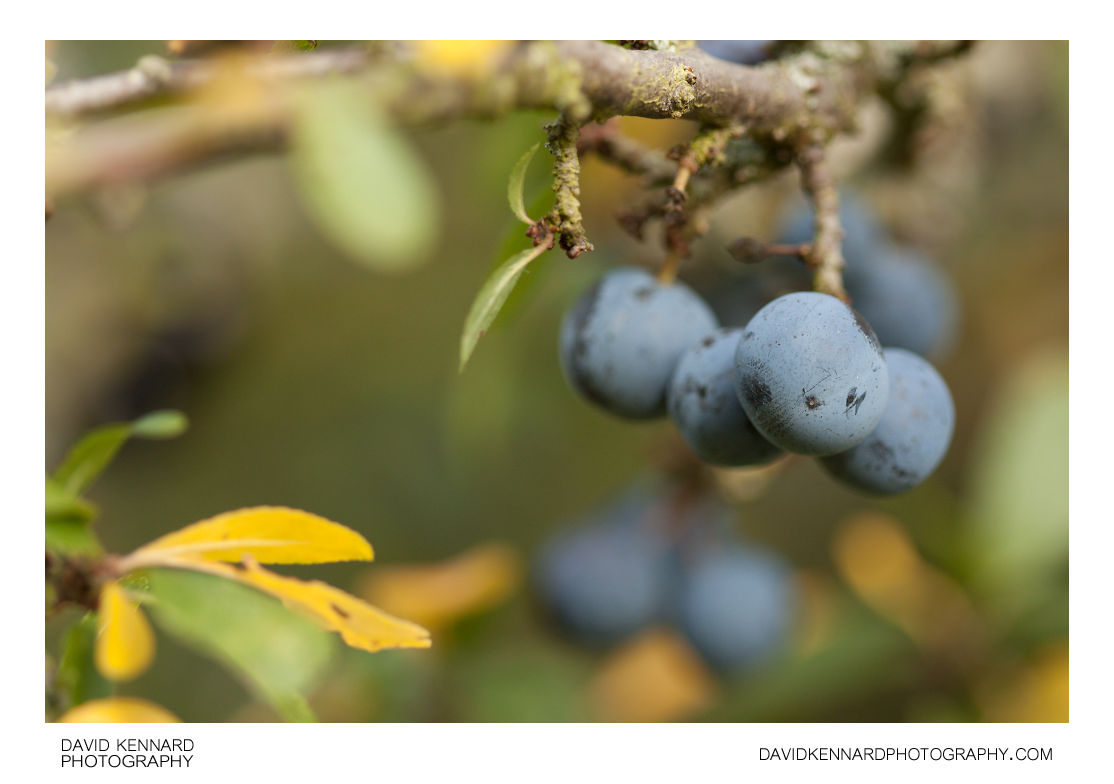Blackthorn sloes

Description
- Title:
- Blackthorn sloes
- Caption / Description:
-
Prunus spinosa (blackthorn or sloe) is a species of Prunus native to Europe, western Asia, and locally in northwest Africa. It is also locally naturalised in New Zealand and eastern North America.
Prunus spinosa is a deciduous large shrub or small tree growing to 5 m tall, with blackish bark and dense, stiff, spiny branches. The leaves are oval, 2 – 4.5cm long and 1.2 – 2cm broad, with a serrated margin. The flowers are 1.5cm diameter, with five creamy-white petals; they are produced shortly before the leaves in early spring, and are hermaphroditic and insect-pollinated.
The fruit, called a "sloe", is a drupe 10–12mm in diameter, black with a pale purple-blue waxy bloom, ripening in autumn, and harvested — traditionally, at least in the UK, in October or November after the first frosts. Sloes are thin-fleshed, with a very strongly astringent flavour when fresh.
The fruit is similar to a small damson or plum, suitable for preserves, but rather tart and astringent for eating, unless it is picked after the first few days of autumn frost. This effect can not be reproduced by freezing harvested sloes, but is the result of the plant withdrawing tannins from the sloes in freezing weather.
The juice is used in the manufacture of spurious port wine, and used as an adulterant to impart roughness to genuine port. In rural Britain, so-called sloe gin is made from the fruit, though this is not a true gin, but an infusion of vodka, gin, or neutral spirits with the fruit to produce a liqueur. In Navarre, Spain, a popular liqueur called patxaran is made with sloes. Wine made from fermented sloes is considered a delicacy in Germany and other central European countries.
Sloes can also be made into jam and, if preserved in vinegar, are similar in taste to Japanese umeboshi. The juice of the berries dyes linen a reddish color that washes out to a durable pale blue.
Description adapted from Wikipedia: http://en.wikipedia.org/wiki/Blackthorn
- Tags / Keywords:
-
- Biota
- Life
- Vitae
- Eukaryota
- Plantae
- Plants
- Magnoliophyta
- Flowering Plants
- Angiosperms
- Magnoliopsida
- Dicotyledons
- Rosales
- Rosaceae
- Roses
- Prunus
- Fruit
- Prunus spinosa
- Blackthorn
- Sloe
- Berry
Admin
- Date Original Photo Taken:
- Original File Name:
- _MG_8583.CR2
- Event:
- Rating:
- ☆
- Date this image added/last updated on website:
- Original File Dimensions:
- 4272px x 2848px
- File Type:
- JPEG
- Color Mode:
- Original Image Color Profile:
- Adobe RGB (1998)
Location
- Location Created:
-
- Sublocation:
- City:
- Marston Trussell
- Province/State:
- Northamptonshire
- Country:
- United Kingdom
- World Region:
- Europe
- Geo-location:
- 52.475505, -0.9575 View on map
Rights
- Copyright Status:
- Copyrighted
- Licensing Status:
- Rights Managed
- Available for Editorial Use:
- Yes
- Available for Commercial Use:
- Yes
- Copyright Notice:
- © 2011 Dave Kennard
Camera Data
- Date Digital Resource was created:
- Shutter speed:
- 1⁄200 s
- Aperture:
- f/3.2
- Camera Model:
- Canon EOS 450D
- ISO:
- 200
- Exposure Compensation:
- 0
- Focal Length:
- 100mm
- Focal Length (35mm equiv.):
- Metering Mode:
- Multi-segment
- Flash:
- Off, Did not fire
- Exposure Mode:
- Manual
- White Balance:
- Manual
- Light Source:
- Exposure Program:
- Manual
Additional shooting metadata
- Lens:
- Canon EF 100mm F2.8 Macro USM
- Filters used:
- Additional Optics used:
- Setup:
- Handheld
Liveview using Hoodeye LCD viewfinder
Post Processing
- Image Modified:
- Software used:
-
- Adobe Camera RAW
- Post Processing:
